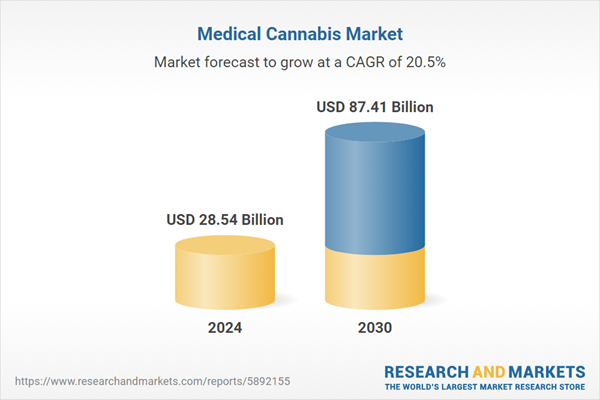The medical cannabis market is expanding rapidly due to increased global acceptance, advancements in legislation, and growing research efforts. Opportunities abound in product diversification, such as edibles and tinctures, and new delivery systems. However, overcoming research constraints and regulatory hurdles remain a challenge.
Medical Cannabis Market
Dublin, May 28, 2025 (GLOBE NEWSWIRE) — The “Medical Cannabis Market – Global Industry Size, Share, Trends, Opportunity, and Forecast, 2020-2030F” report has been added to ResearchAndMarkets.com’s offering.
The Medical Cannabis Market was valued at USD 28.54 Billion in 2024, and is expected to reach USD 87.41 Billion by 2030, rising at a CAGR of 20.51%
This substantial growth is driven by increased government funding, a rise in research and development initiatives, and expanding acceptance of medical cannabis worldwide. Medical cannabis refers to the therapeutic use of the cannabis plant or its derivatives to address various medical conditions such as chronic pain, anxiety, seizures, and nausea.
The market encompasses a broad spectrum of products, including dried flower, oils, capsules, tinctures, and edibles, which can be consumed in different ways based on patient needs. One of the pivotal factors fueling market expansion is the growing societal and medical acceptance of cannabis as a valid treatment alternative. The rise in favorable research outcomes and patient testimonials is further accelerating adoption.
Key Market Drivers
Regulatory Advancements and Legalization
The advancement of medical cannabis legislation globally is a key force behind market growth. Countries such as Canada, Germany, and Australia, along with numerous U.S. states, have implemented legal structures that support medical cannabis usage. For instance, in the U.S., 36 states and 4 territories have authorized its use for medical or recreational purposes. Canada’s longstanding legalization, dating back to 2001 and reinforced by the 2018 Cannabis Act, has cultivated a stable regulatory environment conducive to market expansion.
Key Market Challenges
Limited Clinical Evidence and Research Constraints
While medical cannabis continues to gain traction, a major barrier is the insufficient clinical data validating its effectiveness for various medical issues. Though initial research and anecdotal reports suggest therapeutic promise, extensive clinical studies are essential for determining standardized dosages, safety measures, and treatment efficacy. Regulatory obstacles, especially in regions like the United States where cannabis is categorized as a Schedule I substance, further impede research progression. This classification restricts study approvals and slows the accumulation of conclusive scientific evidence, making it harder for physicians to prescribe cannabis and for patients to receive consistent, data-backed treatment.
Key Market Trends
Technological Innovations and Product Diversification
The medical cannabis sector is rapidly evolving through technological innovations that enable the creation of varied product types and delivery systems. New offerings such as cannabis-based edibles, tinctures, oils, and topicals are emerging to meet diverse patient demands. These advancements not only broaden consumer choice but also support more precise and personalized medical treatments.











